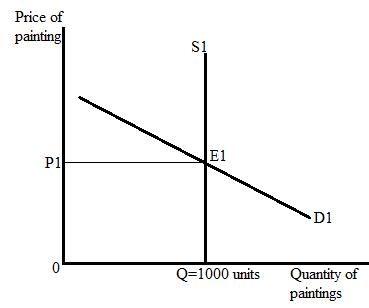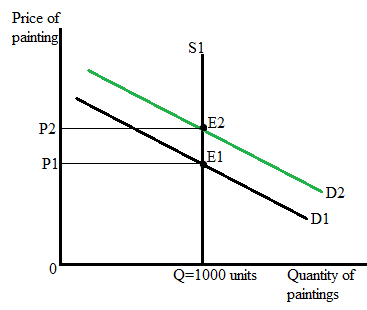
a)
The question requires us to draw the
a)
Explanation of Solution
In the market for paintings, S1 shows the vertical supply curve, and D1 is the
At equilibrium,
Quantity supplied = Quantity demanded = 1000 units.
The following graph represents the market for paintings:

Here, E1 represents the equilibrium point where the supply curve and demand curve intersect each-other. The
The demand curve represents the relationship between the price and quantity demanded of a commodity while the supply curve represents the relationship between the price of a product and the quantity supplied at the given price.
The demand curve is a downward-sloping curve that represents the inverse relationship between the quantity demanded and the price of the product i.e., when the price of a product increases its quantity demanded falls and vice versa. On the other hand, the supply curve is a positive-slope curve that represents the positive relationship between the price of the product and the quantity supplied.
b)
The question requires us to list the five principal factors that impact the price of paintings in the market.
b)
Explanation of Solution
Any change in supply and demand of the paintings will cause the price of paintings to change. The five principal factors that can impact the price of paintings are the following:
- Price of relative products: when the price of similar paintings will fall then the demand and thus the price of Pablo’s paintings will fall as well because consumers will prefer less expensive products over expensive ones.
- Income of consumers: A higher income indicates higher demand for paintings and thus causes the price of paintings to rise.
- Taste and preferences of consumers: Due to some reason consumers start giving preference to Pablo’s paintings and start demanding more. Again a higher demand will cause the price to rise.
- Lack of logistic and market supports: Due to poor connectivity between buyers and suppliers, the price of paintings will change.
- The expectation of a higher price soon: When consumers expect a higher price for the painting soon, they demand more and a higher demand will hike the price level.
c)
The question requires us to determine the impact of high demand on the price of paintings.
c)
Explanation of Solution
The following graph represents the impact of high demand in the painting market:

Here, E1 represents the initial equilibrium state in the painting market. At equilibrium Q represents the equilibrium quantity, and P1 represents the equilibrium price. When wealthy art collectors decide to buy the paintings, the demand for paintings will increase. A higher demand causes the demand curve to shift rightward from D1 to D2, and results in a higher price P2.
E2 represents the new equilibrium point, where P2 is the new market price for the paintings.
An increase in demand will only increase the price of paintings. There will be no impact on quantity because the supply of paintings is fixed.
Chapter 2R Solutions
Krugman's Economics For The Ap® Course
- MC The diagram shows a pharmaceutical firm's demand curve and marginal cost curve for a new heart medication for which the firm holds a 20-year patent on its production. Assume this pharmaceutical firm charges a single price for its drug. At its profit-maximizing level of output, it will generate a total profit represented by OA. areas J+K. B. areas F+I+H+G+J+K OC. areas E+F+I+H+G. D. - it is not possible to determine with the informatio OE. the sum of areas A through K. (...) Po P1 Price F P2 E H 0 G B Q MR D ōarrow_forwardPrice Quantity $26 0 The marketing department of $24 20,000 Johnny Rockabilly's record company $22 40,000 has determined that the demand for his $20 60,000 latest CD is given in the table at right. $18 80,000 $16 100,000 $14 120,000 The record company's costs consist of a $240,000 fixed cost of recording the CD, an $8 per CD variable cost of producing and distributing the CD, plus the cost of paying Johnny for his creative talent. The company is considering two plans for paying Johnny. Plan 1: Johnny receives a zero fixed recording fee and a $4 per CD royalty for each CD that is sold. Plan 2: Johnny receives a $400,000 fixed recording fee and zero royalty per CD sold. Under either plan, the record company will choose the price of Johnny's CD so as to maximize its (the record company's) profit. The record company's profit is the revenues minus costs, where the costs include the costs of production, distribution, and the payment made to Johnny. Johnny's payment will be be under plan 2 as…arrow_forwardWhich of the following is the best example of perfect price discrimination? A. Universities give entry scholarships to poorer students. B. Students pay lower prices at the local theatre. ○ C. A hotel charges for its rooms according to the number of days left before the check-in date. ○ D. People who collect the mail coupons get discounts at the local food store. ○ E. An airline offers a discount to students.arrow_forward
- Consider the figure at the right. The profit of the single-price monopolist OA. is shown by area D+H+I+F+A. B. is shown by area A+I+F. OC. is shown by area D + H. ○ D. is zero. ○ E. cannot be calculated or shown with just the information given in the graph. (C) Price ($) B C D H FIG шо E MC ATC A MR D = AR Quantityarrow_forwardConsider the figure. A perfectly price-discriminating monopolist will produce ○ A. 162 units and charge a price equal to $69. ○ B. 356 units and charge a price equal to $52 for the last unit sold only. OC. 162 units and charge a price equal to $52. OD. 356 units and charge a price equal to the perfectly competitive price. Dollars per Unit $69 $52 MR 162 356 Output MC Darrow_forwardThe figure at right shows the demand line, marginal revenue line, and cost curves for a single-price monopolist. Now suppose the monopolist is able to charge a different price on each different unit sold. The profit-maximizing quantity for the monopolist is (Round your response to the nearest whole number.) The price charged for the last unit sold by this monopolist is $ (Round your response to the nearest dollar.) Price ($) 250 225- 200- The monopolist's profit is $ the nearest dollar.) (Round your response to MC 175- 150 ATC 125- 100- 75- 50- 25- 0- °- 0 20 40 60 MR 80 100 120 140 160 180 200 Quantityarrow_forward
- The diagram shows a pharmaceutical firm's demand curve and marginal cost curve for a new heart medication for which the firm holds a 20-year patent on its production. At its profit-maximizing level of output, it will generate a deadweight loss to society represented by what? A. There is no deadweight loss generated. B. Area H+I+J+K OC. Area H+I D. Area D + E ◇ E. It is not possible to determine with the information provided. (...) 0 Price 0 m H B GI A MR MC D Outparrow_forwardConsider the figure on the right. A single-price monopolist will produce ○ A. 135 units and charge a price equal to $32. B. 135 units and generate a deadweight loss. OC. 189 units and charge a price equal to the perfectly competitive price. ○ D. 189 units and charge a price equal to $45. () Dollars per Unit $45 $32 MR D 135 189 Output MC NGarrow_forwardSuppose a drug company cannot prevent resale between rich and poor countries and increases output from 3 million (serving only the rich country with a price of $80 per treatment) to 9 million (serving both the rich and the poor countries with a price of $30 per treatment). Marginal cost is constant and equal to $10 per treatment in both countries. The marginal revenue per treatment of increasing output from 3 million to 9 million is equal to ○ A. $20 per treatment, which is greater than the marginal cost of $10 per treatment and thus implies that profits will rise. ○ B. $20 per treatment, which is greater than zero and thus implies that profits will rise. ○ C. $30 per treatment, which is greater than the marginal cost of $10 per treatment and thus implies that profits will rise. ○ D. $5 per treatment, which is less than the marginal cost of $10 per treatment and thus implies that profits will fall. ○ E. $30 per treatment, which is less than the marginal revenue of $80 per treatment…arrow_forward
- Consider the figure. A single-price monopolist will have a total revenue of Single-Price Monopolist OA. 84×$13. O B. 92x $13. OC. 84×$33. OD. 92 x $33. C Price ($) $33 $13 MC MR D 84 92 Output The figure is not drawn to scale.arrow_forward10.As COVID-19 came about, consumers' relationship with toilet paper changed and they found themselves desiring more than usual. Eventually, toilet paper producers saw an opportunity to make more money and meet the growing demand. Which best describes this scenario as depicted in Snell's 2020 article? A. The demand curve shifted left and the supply curve shifted left B. The demand curve shifted left and the supply curve shifted right C. The demand curve shifted right and the supply curve shifted left D. The demand curve shifted right and the supply curve shifted rightarrow_forward5. Supply and Demand. The graph below shows supply and demand curves for annual medical office visits. Using this graph, answer the questions below. P↑ $180 $150 $120 $90 $60 $30 4 8 12 16 20 24 28 32 36 a. If the market were free from government regulation, what would be the equilibrium price and quantity? b. Calculate total expenditures on office visits with this equilibrium price and quantity. c. If the government subsidized office visits and required that all consumers were to pay $30 per visit no matter what the actual cost, how many visits would consumers demand? d. What payment per visit would doctors require in order to supply that quantity of visits? e. Calculate total expenditures on office visits under the condition of this $30 co- payment. f. How do total expenditures with a co-payment of $30 compare to total expenditures without government involvement? Provide a numerical answer. Show your work.arrow_forward

 Principles of Economics (12th Edition)EconomicsISBN:9780134078779Author:Karl E. Case, Ray C. Fair, Sharon E. OsterPublisher:PEARSON
Principles of Economics (12th Edition)EconomicsISBN:9780134078779Author:Karl E. Case, Ray C. Fair, Sharon E. OsterPublisher:PEARSON Engineering Economy (17th Edition)EconomicsISBN:9780134870069Author:William G. Sullivan, Elin M. Wicks, C. Patrick KoellingPublisher:PEARSON
Engineering Economy (17th Edition)EconomicsISBN:9780134870069Author:William G. Sullivan, Elin M. Wicks, C. Patrick KoellingPublisher:PEARSON Principles of Economics (MindTap Course List)EconomicsISBN:9781305585126Author:N. Gregory MankiwPublisher:Cengage Learning
Principles of Economics (MindTap Course List)EconomicsISBN:9781305585126Author:N. Gregory MankiwPublisher:Cengage Learning Managerial Economics: A Problem Solving ApproachEconomicsISBN:9781337106665Author:Luke M. Froeb, Brian T. McCann, Michael R. Ward, Mike ShorPublisher:Cengage Learning
Managerial Economics: A Problem Solving ApproachEconomicsISBN:9781337106665Author:Luke M. Froeb, Brian T. McCann, Michael R. Ward, Mike ShorPublisher:Cengage Learning Managerial Economics & Business Strategy (Mcgraw-...EconomicsISBN:9781259290619Author:Michael Baye, Jeff PrincePublisher:McGraw-Hill Education
Managerial Economics & Business Strategy (Mcgraw-...EconomicsISBN:9781259290619Author:Michael Baye, Jeff PrincePublisher:McGraw-Hill Education





